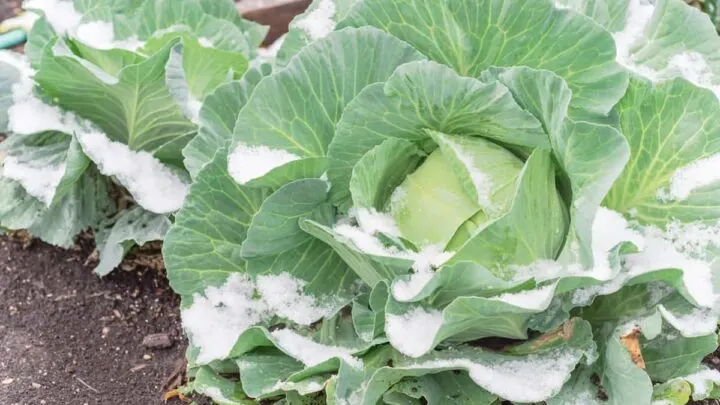Cabbage is an interesting and leafy vegetable. It’s typically planted earlier in the year than many other crops. This may surprise some newer gardeners considering that earlier planting dates mean colder growing temperatures. The cold can damage a lot of crops. You must be asking, do cabbage plants freeze?
Cabbage plants can freeze if you plant them as a fall crop instead of a spring one. Colder temperatures can cause cabbage plants to freeze when planted in the fall. That is usually before the first frost date. That date will vary depending on the region you live in.
Cabbage can withstand temperatures of 26 degrees Fahrenheit but must be planted 6-8 weeks before the last frost date. That way, they aren’t growing in the cold for too long.
Read on to learn about cabbage and the conditions in which it can grow.

Will Cabbage Plants Survive A Freeze?
Yes, cabbage plants can survive temperatures as low as 26 degrees Fahrenheit. That’s 6 degrees lower than the proven freezing temperature of 32 degrees Fahrenheit; therefore, they must be completely frozen.
However, cabbage can survive a freeze. It’s not ideal for them to grow in the cold for too long. The best time of the year to plant cabbage is 6-8 weeks before the first frost date. That date may change significantly depending on the area of the world you live in.
Many experienced gardens say that frost will better the flavor of your cabbage plants, making them much sweeter. So be sure to time your frost date correctly so your cabbage plants get the cold exposure they need to flourish and not too much.
How To Protect Cabbage From The Frost
If you are consistently experiencing temperatures below 26 degrees Fahrenheit for an extended period, you must take preventative measures to protect your cabbage from the frost. Below is a list of helpful tips to protect your cabbage plants when weather conditions are less desirable.
- Check your local gardening store for row covers. They are typically made of polyester and will be specifically placed over your cabbage plants to protect them from too much frost. Ensure they are the proper thickness and weight for cabbage plants to withstand.
- Use old bed sheets, linens, or other medium-weighted cloth to lay over your cabbage plants. This can help lock some heat in and prevent frost from building up on the leaves.
- Hang your chosen material loosely over your cabbage plants. This will allow the circulation of air throughout the plants. Use stakes or a trellis to support the cloth and prevent them from directly touching your plants.

- Use a heavy object as a weight to ensure your cloth is anchored to the ground. You may need several of them to encircle all your plants.
- Make your covers removable. Cover your plants up to protect them when the temperatures decrease rapidly at sundown. Uncover them when temperatures warm to ensure your cabbage plants are receiving an adequate amount of sunlight.
- For much smaller plants, you can try placing a thin layer of mulch or straw over the top of them to hold heat until excessive cold and frost have passed. You can then pick the mulch off.
- Another way to cover much smaller plants is with milk cartons or soda bottles. Slice them in half and place them over your plants. If you dig them into the soil with the sharp side, they will secure themselves to the ground. These are easy to take on and off as frost comes and goes.
- Make sure your plants are thoroughly watered. Adding water that can freeze and turn to ice may sound contradictory, but moisture helps hold the heat into the soil.

When Should I Plant My Cabbage?
Cabbage can be a spring or a fall crop. If cabbage is planted in the spring, you must pick a date around four weeks after the last frost. However, as mentioned above, many believe cabbage plants exposed to frost are sweeter and better to eat, meaning gardeners recommend planting them in the fall instead of the spring.
Fall cabbage must be planted 6-8 weeks before the first frost, ensuring exposure to colder temperatures. Your cabbage plants also need adequate sunlight, so finding the perfect day to plant your cabbage can be a science. Based on your growing region, research thoroughly to ensure you are planting at the right time.
| Spring Cabbage | Plant 4 weeks after the last frost date. |
| Fall Cabbage | Plant 6-8 weeks before the first frost date. |
Final Thoughts
Overall, frost is a dangerous thought to many gardeners used to growing fruits and vegetables. Most seed labels tell you to plant after the last frost date to avoid colder weather. Cabbage, however, thrives in being exposed to frost for brief amounts of time.
Frost makes cabbage taste sweeter and better. Like most crops, cabbage requires a balance of many different elements. If you fear planting your cabbage too early, don’t be too afraid of the cold temperatures.
Refer to the list above of helpful ways to protect cabbage from excessive damage. Your cabbage plants will freeze at some point if planted before the first frost, but with enough care, they will survive and even turn out better in the end.

Hi there, my name is Allie and welcome to my blog; GareningWithAllie!
Much of what you see written here is just our personal experiences with gardening. Along with the content I write here, there is also a unique collection of gardening topics covered by some of our close friends. I hope you find everything you read here to be helpful, informative, and something that can make your gardening journey the most lovely experience ever! With that said, Happy Gardening!
